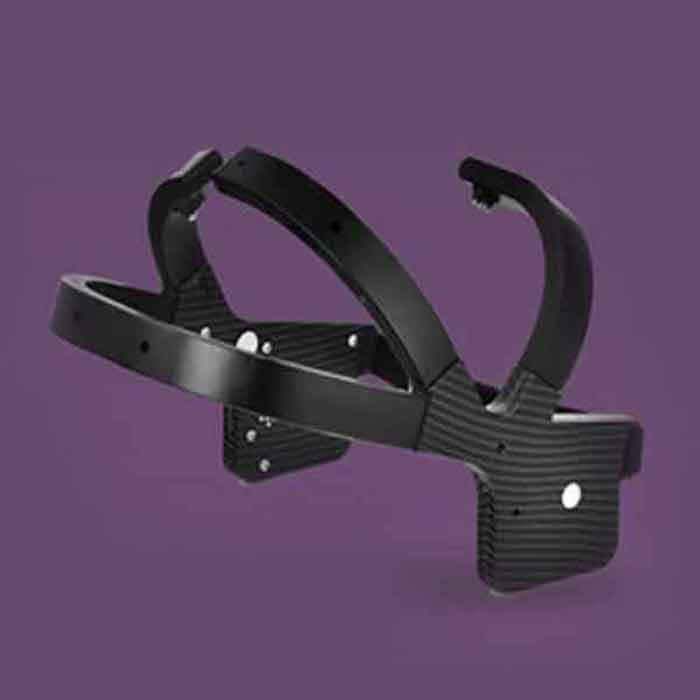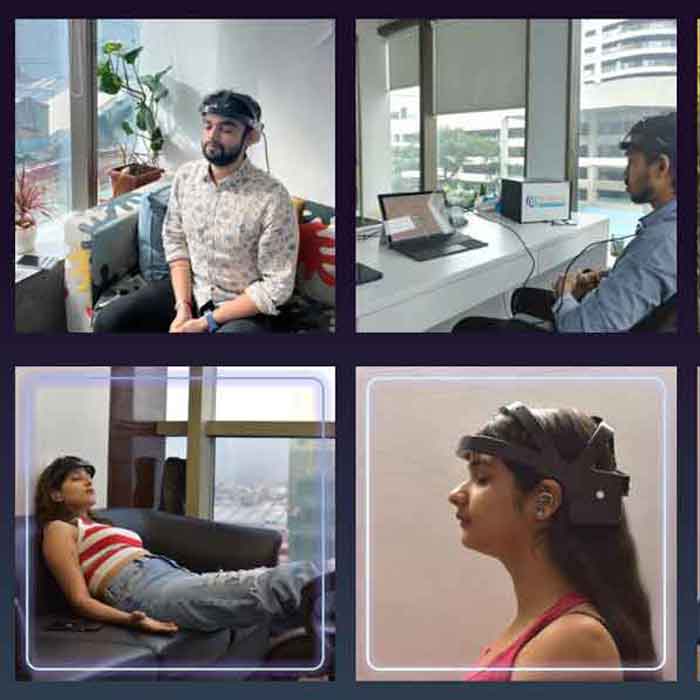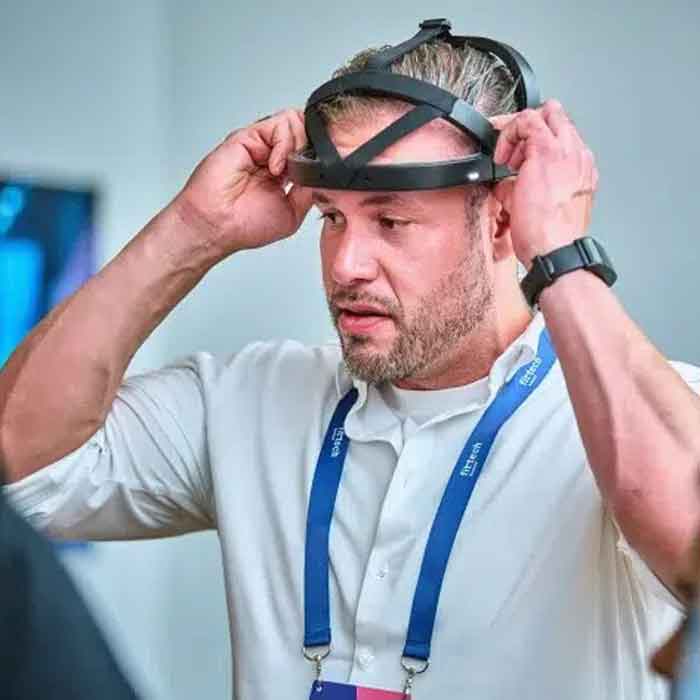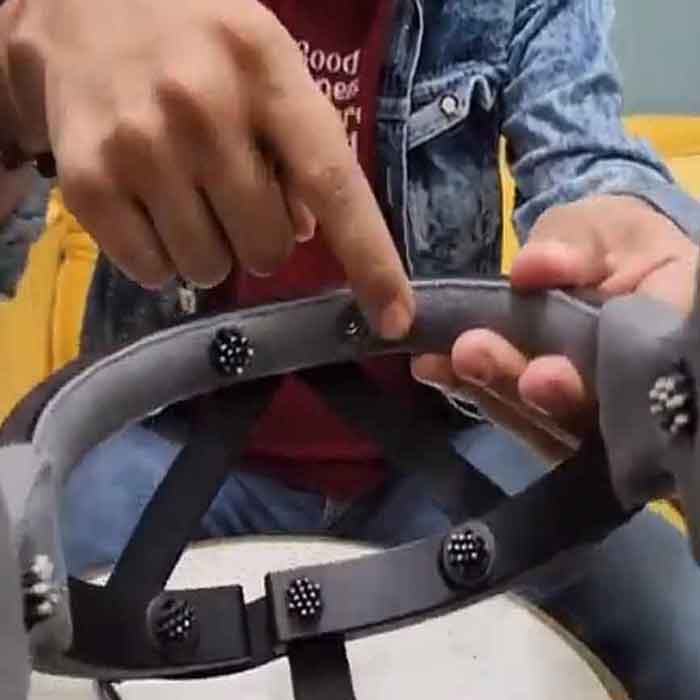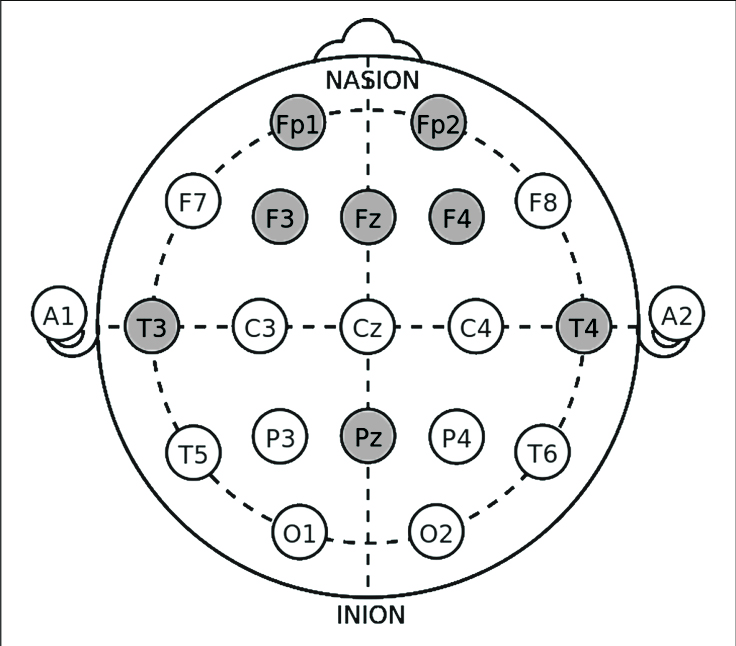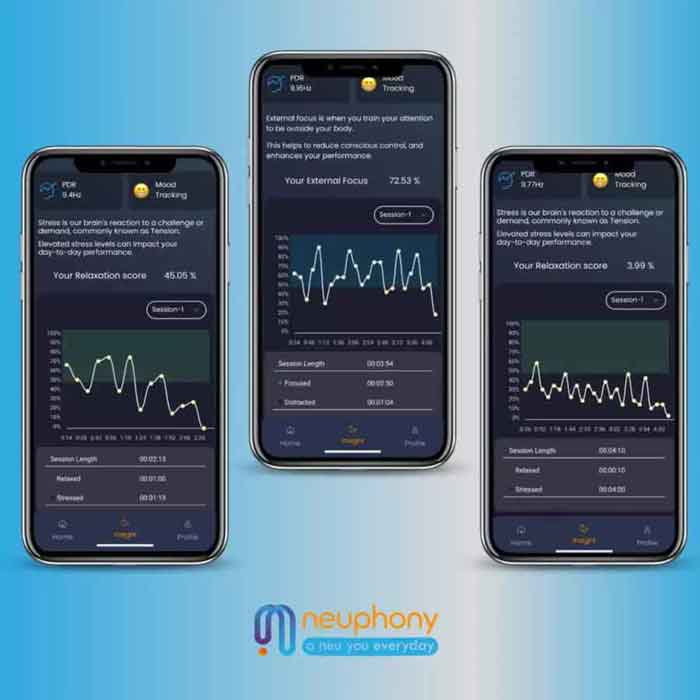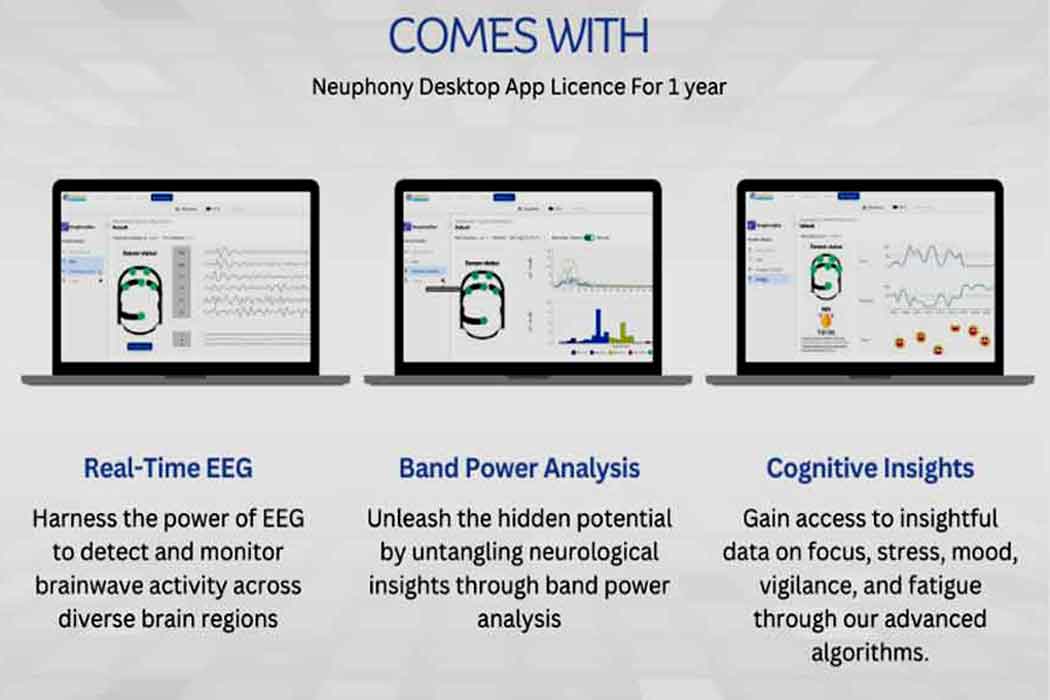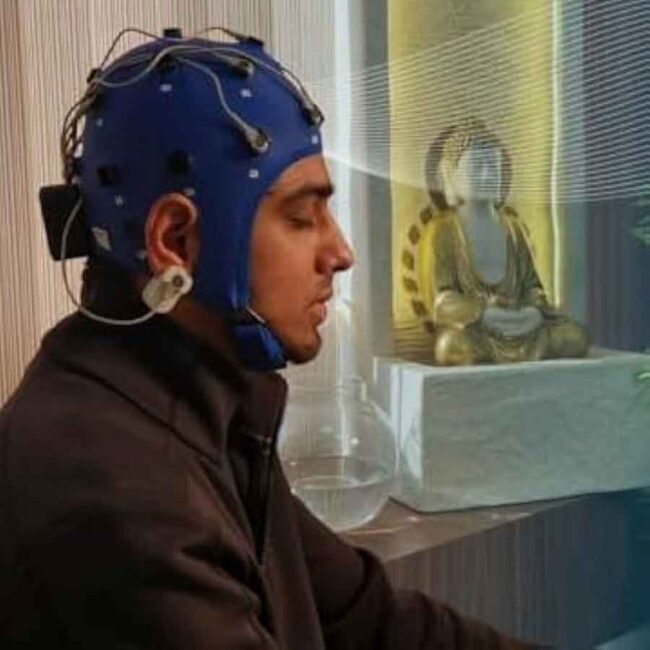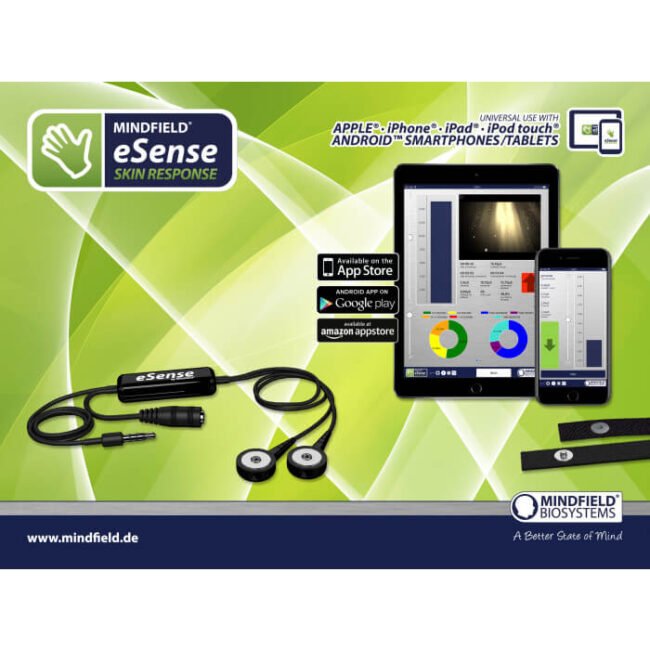Description
Neuphony is a neurofeedback-based wearable brain device (EEG Headset) with 8 Dry EEG Sensors that capture key mind parameters and allow users to know their stress and external focus scores. Neuphony EEG Headset can help you enhance your mental well-being and improve your focus through meditation, neurofeedback, and optimizing your lifestyle. Neuphony was designed so that it can be used by researchers as well as general consumers, as it has placed the minimum number of sensors in the right places to obtain various data.
We are constantly comparing ourselves or competing against 8 Billion people in every facet of our lives. This is a reason we are becoming more stressed, and nothing we do seems to be enough. This constant stress and self-doubt is the reason we see a rise in burn-outs, insomnia, and other preventable anxiety and stress-related disorders. So often, we ignore brain health because we do not have awareness of its importance. To first prescribe the cure, the problem has to be discovered.
Neuphony is a neurofeedback-based wearable brain device (EEG Headset) that captures key mind parameters and allows users to know their stress and external focus scores.
Neuphony uses 8 dry EEG Sensors and Neurofeedback, which help measure, analyze, and train your brain health. Neuphony believes in the unlimited potential of the human mind and strives toward unlocking it to bring out the best in it. Neurofeedback has been scientifically proven to be a powerful tool to improve the overall health of your brain, including improving focus and memory and reducing stress and anxiety. Neuphony brings you the benefits of neurofeedback in the comfort of your home with the help of an EEG headset and a mobile application.
Neuphony works on the unlimited potential of the human mind and aims to unlock it. Neurofeedback has been scientifically proven to be a powerful tool to improve the brain’s overall health, including improving memory and sleep quality and reducing stress and anxiety. Neuphony brings the benefits of neurofeedback to the comfort of people’s homes with the help of an Electroencephalogram (EEG) headset and a mobile application.
The headset measures the electrical activity of your brain, and the mobile app, based on the sensor data, recommends meditation techniques to achieve your desired state. Over multiple sessions, it trains your brain to achieve the desired state.
What cognitive states measure Neurophony EEG headset
Neurofeedback is a biofeedback technique that harnesses brainwave monitoring technology to assist individuals dealing with various mental and physical health conditions. By utilizing electrical signals from the brain neurofeedback helps regulate mood, behavior, and physiological functions, offering a safe and drug-free alternative to traditional treatments. It promotes neuroplasticity, the brain’s ability to reorganize and adapt throughout life, by forming new neural pathways in response to experiences. Neuphony, with its real-time neurofeedback system called “Volume Modulation,” provides immediate feedback to users during meditation sessions, adjusting the volume based on their focus and calm levels. This feedback enables individuals to better understand their attention span, distractions, and feelings of anxiety. Neuphony’s app features user-friendly graphical representations of focus/calm levels, along with mood tracking. Neurofeedback utilizes various protocols focusing on different brainwaves, such as theta, alpha/theta ratio, and beta.
The device has 8 sensors (Fp1, Fp2, F3, F4, Fz, T3, T4, Pz) distributed in the brain’s parietal, frontal, and temporal lobes. These are the polymer sensors that are conducive.

Neurophony measures the following Cognitive States:
• Stress Vs Calm
• Mood Analysis
• External Focus Vs Distractions
• PDR (Posterior Dominant Rhythm)
By cleverly analyzing data from three different lobes – the frontal lobe (Fp1, Fp2, Fz), which controls concentration and emotions; the temporal lobe (T3, T4), which controls auditory perception and memory; and the parietal lobe (Pz), which controls somatosensory perception – Neuphony can accurately respond to many use cases with neurofeedback.
Relaxation Levels: When we enter a state of relaxation, our brain exhibits distinct patterns. Increased alpha band power in the occipital region (located at the back of the head) is associated with relaxation. Additionally, a decrease in beta band power in the frontal region suggests a state of relaxation. By monitoring these patterns real-time analysis can provide valuable insights into our relaxation levels.
Focus Levels: The heightened focus is a sought-after mental state for many tasks. Real-time analysis reveals that increased beta band power in the brain’s frontal and parietal regions indicates heightened focus. Furthermore, a decrease in theta band activity in the prefrontal cortex suggests improved attention and focus. By measuring these patterns, cognitive insights can be derived regarding our focus levels.
Vigilance: Vigilance refers to a state of heightened alertness and attentiveness. Real-time analysis indicates that increased beta band power in the central and parietal regions of the brain suggests heightened vigilance. Moreover, a decrease in alpha band power in the occipital region correlates with improved vigilance. By monitoring these patterns, cognitive insights can be gained regarding our level of vigilance.
Mental Fatigue: Mental fatigue can significantly impact cognitive performance. Real-time analysis allows us to identify brainwave patterns associated with mental fatigue. Increased theta band activity in the frontal and central regions indicates fatigue, while a decrease in beta band power in the parietal and occipital regions suggests fatigue-related cognitive impairment. By analyzing these patterns, cognitive insights can be gleaned about our mental fatigue levels.
Mood: Our mood plays a crucial role in our overall well-being. Real-time analysis can provide valuable information about our mood states. Increased alpha band power in the left prefrontal cortex is correlated with a positive mood. Conversely, decreased beta band power in the frontal region may indicate a negative mood state. By examining these patterns, cognitive insights can be obtained regarding our mood.
Posterior Dominant Rhythm (PDR): The posterior dominant rhythm (PDR) is an alpha band rhythm prominently observed in the occipital region during relaxed wakefulness.

It reflects the resting-state activity of the visual cortex. By analyzing PDR patterns, researchers and clinicians can gain insights into the baseline activity of the visual cortex, contributing to a better understanding of brain function and cognitive processes.
Neurophony EEG Headset Application Sphere
Neuphony EEG headsets offer versatile applications across diverse domains, providing valuable insights into brain activity and cognitive function. Understanding the specific indications for using the Neuphony EEG headset is crucial for maximizing its effectiveness and tailoring interventions to individual needs.
By recognizing the diverse indications for using the Neuphony EEG headset and its application across different fields, users can harness the full potential of this device to achieve their goals and enhance various aspects of brain health and cognitive function. Whether for clinical applications, research endeavors, or personal wellness initiatives, Neuphony EEG headset offer versatile and effective solutions tailored to individual needs and preferences.
1. Meditation and Mindfulness:
2. Stress Reduction and Relaxation
3. Sleep Monitoring and Optimization:
4. Cognitive Training and Performance Enhancement:
5. Cognitive Rehabilitation:
6. Academic and Educational Settings
7. Personalized Brain Monitoring:
8. Performance Optimization in Sports and Athletics:
9. Personal Wellness and Self-Improvement:
10. Brain-Computer Interface (BCI) Development:
By addressing specific health conditions and tailoring interventions to individual needs, Neuphony EEG headset offer versatile and effective solutions for improving brain health, cognitive function, and overall well-being across diverse populations and settings.
Here’s how Neuphony EEG headset can be utilized for specific health conditions:
1. Headache,
2. ADHD (Attention-Deficit/Hyperactivity Disorder),
3. PTSD (Post-Traumatic Stress Disorder),
4. Recovery After Stroke,
5. Anxiety Disorders,
6. Depression,
6. Chronic Pain,
7. Neurodevelopmental Disorders (e.g., Autism Spectrum Disorder),
8. Bipolar Disorder,
9. Traumatic Brain Injury (TBI),
10. Age-related cognitive Decline,
11. Substance Use Disorders,
14. Obsessive-Compulsive Disorder (OCD).
In summary, Neuphony EEG headset offer versatile applications in the management of various health conditions, providing individuals with valuable tools for monitoring brain activity, enhancing cognitive function, and promoting overall well-being. Whether as standalone interventions or as part of comprehensive treatment plans, these headbands have the potential to improve outcomes and quality of life for individuals with diverse health needs.
How to use a Neuphony EEG headset
Turn on the device, connect it to the mobile application, choose meditation music from the list, and start the session. After the session, you’ll be able to see the graphs where you’ll see the focus, relaxation scores, etc. based on the type of meditation you chose.
After getting the device and the app, you can measure your brain’s state (mood) by measuring your brain waves under normal conditions. After that, you can start the meditation through the app. This will apply the most appropriate meditation according to the mood, such as “not enough focus”. During meditation, auditory stimulation feedback using the volume of background music provided according to the brain’s activity state guides you to a deeper meditation. At the end of the session, you can view your insight through a dedicated dashboard.
There are different ways you can indulge in meditation with the app.
1. In-built modules integrated with Neurofeedback :
• Improved external focus
• Reduce stress and anxiety
2. Meditate in peace
3. Mediate using YouTube
NOTE: Please note that the Neurofeedback is available only in the in-built modules and not available if you opt for external audio sources.


Neuphony EEG headset using guide
Finding The Right Meditation For You
The first step in using Neuphony effectively is to find the type of meditation that works best for you. This will help you reduce stress and anxiety while also improving your focus and concentration. Here’s a suggested plan for your first day.
Day 1:
1. Choose one session from the ‘Improve External Focus’ category and one session from the ‘Reduce Stress and Anxiety’ category in the Neuphony app.
2. Schedule your first session for 1 hour after your first meal of the day, preferably within 4 hours of waking up. Example: If you wake up at 6 am and have breakfast at 9 am, schedule your first Neuphony session at 10 am.
3. Take the second session 4-6 hours after the first session.
4. Take a third session 4-6 hours after the second session.
Use the same music for all three sessions, whether it’s your favorite relaxation music or guided meditation audio.
Day 2-4:
Repeat the schedule from the previous day, using the same music.
It’s important to note that the quantifiable effects of meditation may take at least 4 weeks to become noticeable.
However, if you experience significant variability (more than 50% difference) in your focus and relaxation scores, it could indicate that you might prefer a change of audio.
In that case, try a different category of meditation or a different category of music for the next 4 days. Once you find music or audio that resonates with you, make use of the integrated neurofeedback in the Neuphony app.
Reducing Stress Levels With Consistency And Meditation
Managing stress is crucial for maintaining good mental health. Neuphony can help you achieve this by incorporating stress-reducing practices into your daily routine. Here’s a suggested plan:
Day 1:
1. Select a module from the ‘Reduce Stress and Anxiety’ section in the Neuphony app. Use the Preview option to listen to the audio before starting your session.
2. Schedule your first session for 1 hour after your first meal of the day, within 4 hours of waking up. Example: If you wake up at 6 am and have breakfast at 9 am, schedule your first session at 10 am.
3. Take the second session 4-6 hours after the first session.
4. Take a third session 4-6 hours after the second session.
5. Use the same module for all three sessions.
Day 2-7
Repeat the previous day’s schedule, using the same module.
Consistently engaging in stress-reducing neurofeedback sessions can lead to a noticeable decrease in stress levels over time. Similar to the previous plan, it may take at least 2 weeks to see quantifiable effects.
If you observe significant variability (more than 50% difference) in your relaxation scores, try a different category of meditation or music while sticking to the same schedule for the next week.
Optimize Your Lifestyle & Diet For Better Mental Health
Your lifestyle and diet play a crucial role in your overall mental well-being. Neuphony can help you identify the effects of specific food items on your focus and relaxation scores. Here’s a suggested plan:
Day 1:
1. Schedule your first Neuphony focus and relaxation session 1 hour after your first meal of the day, within 4 hours of waking up. Example: If you wake up at 6 am and have breakfast at 9 am, schedule your first session at 10 am.
2. Use the Add Tag feature in the app to enter the details of your breakfast, noting down the components of your meal.
3. Repeat the process for your second session, scheduling it an hour after lunch and noting down the food components again.
Day 2-4:
Repeat this exercise on each workday, keeping track of your meals using the Add Tags feature. If you happen to skip a meal, add that information as well.
After completing the first week, you’ll have enough data to pinpoint the effects of specific food items on your focus and relaxation scores. For reliable results, consume the same food at least 5 times around the same time of day and calculate the average of the five sessions.
Making The Most Out Of Neurofeedback Provided By Neuphony
Neurofeedback is a powerful feature of Neuphony that can help train your brain for better focus and concentration. Here’s how you can maximize its benefits:
1. Familiarize yourself with how neurofeedback works in the app. Neuphony employs volume modulation to provide real-time feedback on your cognitive performance.
2. During a focus module, if you notice an increase in the volume of the music, it indicates that your focus is increasing as well.
3. Your task is to maintain the mental state and thoughts that helped you achieve that level of focus. This may be challenging at first but becomes easier with practice, typically after around 10-20 sessions.
4. The training effect of neurofeedback goes beyond the active focusing period. It helps your brain maintain better focus levels even when you’re not actively engaged in focusing.
5. You can observe and quantify the benefits of this brain training after approximately 30-40 sessions.
To Get Started With Neurofeedback:
1. In the first week, explore the focus and calm modules in the Neuphony app to find the ones you enjoy the most. You can also add your music to the app and use that to measure your focus and calm levels.
2. Establish a routine for your sessions. Decide whether you want to have sessions once a day, daily for two weeks, or every alternate day. Keep the frequency of sessions regular, with a minimum of 3 sessions per week.
3. Spread out around 30 sessions over at least 4 weeks. Doing all 30 sessions in a week won’t be as effective, so patience is key.
4. Start your session routine and keep track of your progress.
By following these guidelines, you can make the most out of your first week using Neuphony. Remember that everyone’s experience may vary, so be open to experimenting and finding what works best for you. Enjoy your journey to improved mental well-being!
Neuphony EEG Headset Technical Specifications


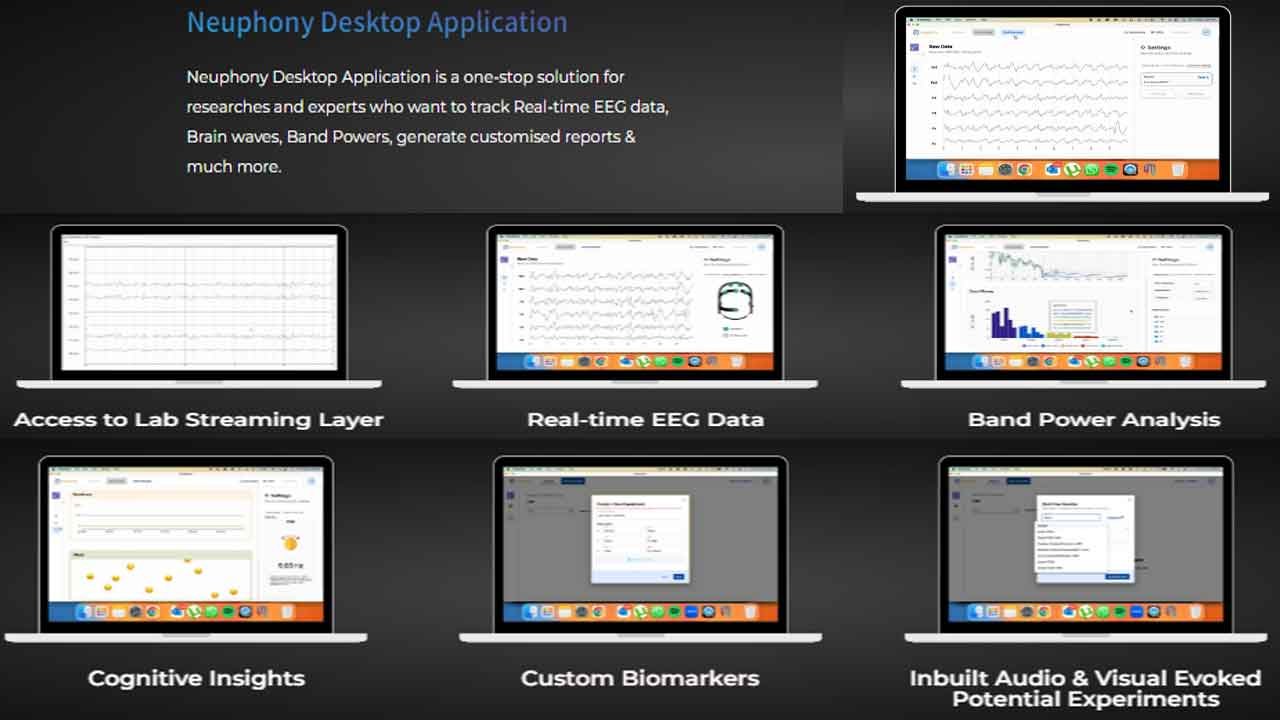
Benefits
Neuphony helps you validate your brain state with data. It helps you improve your focus and reduce stress with meditation.
Lifestyle tips and suggestions
Take at least two sessions a day; one in the morning and one in the evening. Measure and analyze how your brain parameters are changing with your lifestyle etc. and how you can improve yourself by training your brain better.
By following these tips and guidelines, you can use the Neuphony EEG headset effectively to achieve your goals and maximize the benefits of personalized brain monitoring and neurofeedback training. Whether for enhancing meditation practices, improving cognitive performance or health conditions, or managing stress, the Neuphony EEG headset offers valuable tools for unlocking the full potential of your brain.

